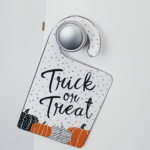31 Jan Warning signs promote the joy of reading
Kris Bordessa’s sons have a tendency towards truncation in their communication
The bright, bold colours of billboards and street signs intrigued my oldest son, Brad, long before he could read. “What does that say, Mum?” he’d ask from the back seat as we whizzed down the highway. In no time, he was reading signs on his own.
The day he yelled, “Stop!” at the top of his lungs, I breathlessly slammed on the brakes. Once my brain had registered our lack of impact with any other vehicle or pedestrian, I looked in the rear-view mirror, only to see my preschooler triumphantly pointing at the big red ‘Stop’ sign looming ahead of us. I’d been stopping at those signs for years before I had help from my pintsized passenger, but I now lived in fear that his exuberance would cause an accident.
Brad would drag me by the hand to excitedly show me an ‘Exit’ sign or forcibly prevent me from ignoring a ‘Do not enter’ sign. He took his signage seriously. Soon he was sharing the joy of sign reading with his younger brother, pointing out to Evan all of the words he recognized on our drives. As Brad outgrew his interest in street signs and turned to simple books, his brother’s interest in reading signs accelerated.
I shouldn’t have been surprised when I started finding crudely lettered signs taped about the house. “Kep owt! No big boys!” proclaimed one; “My room” announced another.
My sons’ affection for signs had spilled over into our daily lives. Most of the signs that my boys created yielded a glimpse into how they were feeling, becoming a kind of written barometer that I used to gauge their emotions. But some simply made me wonder what inspired their creation.
One day, Evan yelled to me at the other end of the house, “Mum, how do you spell peace?” “What kind of ‘piece’?” I asked. “Piece like a piece of bread, or peace as in peaceful?” “Peaceful.” I spelled it out, not giving it a second thought. Until I spotted the sign. Plastered on a bathroom door, scrawled in big letters with yellow crayon was a sign: ‘Poo in Peace’.
Oddly, this bathroom had become the kids’ preferred choice, because, they claimed, it was quieter. While some parents might cringe at such a sign, I found it to be unobtrusive – and oddly comforting.
Perhaps this is because I, too, utilize words to keep track of my day, my week, my life. A cluttered whiteboard hangs above my desk, with reminders of all that I need to accomplish. Occasionally, I cross something off.
Sticky notes remind me of promises that must be kept and tasks that must be completed. I’ve even been known to use notes to communicate with my sign-reading kids: “Brush your teeth” or “Make your bed” – as an alternative to constant verbal reminders. “Did you see my sign?” is much more intriguing than, “Have you brushed your teeth?” And, of course, incensed when I ignore an instruction to “nok ferst”, my kids ask me the same question”.
I know that those scrawled messages will someday stop appearing. No more will I stop in my tracks to see the demand of the day. I’ll be left with my whiteboard and sticky notes, and shopping lists that request ‘deodorant’ and ‘mouthwash’ in a teenager’s script. And, I foresee a day when wistful about the passage of time, it will be my turn to shout from the back seat of parenthood, ‘Stop!’ Just stop.



